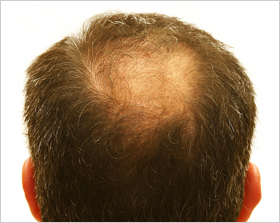 Most men—and some women—experience some degree of hair loss (balding) as they grow older. In the normal cycle of hair growth, it is natural to lose up to 100 hairs per day. If you are losing more than that, or if your hairline becomes more prominent, it could be a sign of excessive hair loss.
Most men—and some women—experience some degree of hair loss (balding) as they grow older. In the normal cycle of hair growth, it is natural to lose up to 100 hairs per day. If you are losing more than that, or if your hairline becomes more prominent, it could be a sign of excessive hair loss.
The medical term for hair loss is alopecia. The most common type of hair loss in men is male pattern baldness, or androgenic alopecia. This is an inherited tendency to stop producing new hairs.
Each hair follicle produces a single hair that normally grows about a half inch per month for about 4 to 6 years. It then goes into a resting phase and loses the hair before growing a new one. The number of hair follicles entering the resting phase is equal to the number of hair follicles starting the growth phase, so the number of hairs on the head remains the same.
With androgenic alopecia, an increasing number of hair follicles never recover from the resting phase, resulting in a scalp with less hair. This loss of active hair follicles may take place over months or years before it is noticeable.
The hair follicles that usually stop producing new hairs are located along the frontal part of the scalp and along the crown of the head. This results in a receding hairline and/or balding at the top of the head.
Other causes of hair loss include:
- Alopecia areata, an autoimmune disorder that attacks the hair follicles, shrinking them and inhibiting hair growth (can also lead to bald spots of facial hair)
- Stressful events, such as major surgery
- Medications that can damage hair follicles, such as chemotherapy or blood thinners
- Fungal infections (tinea capitis)
- Chronic illnesses, such as diabetes or lupus
What Are Some Treatments for Hair Loss?
Many men are dismayed enough by their balding appearance to seek medical advice and possible treatment.
Hair loss due to androgenic alopecia does not go away on its own and cannot be cured. But the following treatments may slow hair loss or promote hair growth:
- Minoxidil (Rogaine). This topical, over-the-counter medication has been shown to regrow hair and prevent further hair loss in some people with alopecia areata and male pattern baldness. It is rubbed into the scalp twice per day. Minoxidil only works while you are taking it, so any new hair will stop growing if you discontinue use of the medication. Results may not be seen until after 6 months of use.
- Finasteride (Propecia). This prescription medication is taken by mouth once a day and is designed to treat male pattern baldness. It works by decreasing the growth of DHT, a hormone that shrinks hair follicles and inhibits hair growth. As with minoxidil, the benefits of finasteride stop if you stop using it. Results may not be seen until after 6 months of use.
The effectiveness of these medications depends on the cause and extent of hair loss and each person’s individual response. Usually, the more recent the hair loss, the more effective the treatment will be. Extensive hair loss probably won’t respond well to medications.
One other option for treating hair loss is hair transplantation, where tiny plugs of hair-growing skin are removed from one part of the scalp and re-implanted on the balding areas.
Hair Transplantation
Hair transplantation transfers hair follicles from areas of thick growth (“donor” sites) to balding areas (“recipient” sites).
Hair transplantation is commonly used for the treatment of male pattern baldness and female pattern hair loss (androgenic alopecia). It may also be used to treat other forms of hair loss.
The hair that grows from transplanted follicles will have the same color and texture it had before it was moved.
Source: Vivacare
Last updated : 5/13/2022